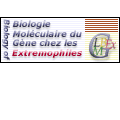
|
|















|
International Summer School
From Genome to Life:
Structural, Functional and Evolutionary approaches
DUFRESNE Alexis |
|
Station Biologique de Roscoff, Equipe Phytoplancton Oceanique, Place Georges Tessier, BP74, Roscoff 29682, France title: Analysis of the genome of Prochlorococcus marinus SS120 and preliminary comparative analyses with three other marine cyanobacteria genomes Since its discovery in the late 80‚s, the marine photosynthetic prokaryote Prochlorococcus has proven to be the photosynthetic organism the most abundant on Earth and it has a key ecological role in the central areas of the world ocean. With a diameter of 0.5 to 0.7 mm, Prochlorococcus is also the smallest photosynthetic organism known to date. Studies on natural populations and cultured strains of this prokaryote suggest that at least 2 ecotypes (or possibly species), characterised by different physiology and genetic signature, are present in the water column and are adapted to different ecological niches (e.g. high light/low nutrient in surface and low light/high nutrient at depth). Recent molecular studies comparing Prochlorococcus strains have shown striking examples of ecotypic differenciations, such as specific multiplication or loss of genes encoding proteins of the light harvesting complex or enzymes of the nitrogen metabolism. Thus, examining Prochlorococcus genomes can allow to assess the effects of the environmental factors on the genome evolution of a free-living prokaryote. One genome of a high light/low nutrient adapted strain (MED4) and two genomes of a low light/high nutrient adapted strain (MIT9313 and SS120) have recently been sequenced by the Joint Genome Institute (JGI, Walnut Creek, CA) and the Genoscope (Evry, France). Comparison of these 3 Prochlorococcus genomes should allow to understand much better the molecular bases of the ecophysiological differences between the 2 ecotypes as well as to find new examples of adaptation to the ecological niches. |